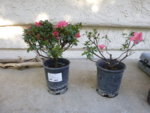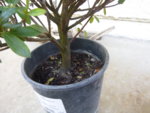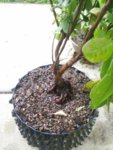If you lined up a dozen azaleas of equal trunk diameters, and 6 were Satsuki types and 6 were other types of azalea, chances are fairly good that 5 of the 6 Satsuki's would rate as ''better'' bonsai when scoring such things as leaf size, ability to back bud, ramification, proportions, and so on. Pretty much across the board, Satsuki and Kurume azaleas rate very high as bonsai.
Now if you compared the 6 non-satsuki azalea, to 6 flowering trees of other genera, for example Malus, Prunus, Cotoneaster, and so on, At least some of non-Satsuki azalea would probably hold their own. Some species of azalea will make good bonsai when compared to things like Malus.
Also keep in mind, the term Azalea is a horticultural term. There is no botanical distinction that separates azalea from Rhododendron. Some things routinely called Rhododendron have leaves as small or even smaller than an Azalea. Though it is true the majority of evergreen Rhododendrons have larger leaves than Satsuki azalea. Satsuki azalea are the group of hybrids from the species Rhododendron indica, with a dozen or so other species mixed in. Rhododendron dauricum is talked about by gardeners as a Rhododendron, not an azalea, yet it has leaves that are as small as any Satsuki azalea. I saw a photo posted a few years back of a lovely bonsai styled from R. dauricum. The distinction between the groups is an arbitrary one. A read worth slogging through is the Rhododendron page of Wikipedia. There the botanical classification of Rhododendron is outlined, and some species information is available too.
So what is my point. Satsuki azaleas (Rhododendron indica hybrids) possess multiple traits that make for attractive bonsai. It is not just about the flowers. The leaf size, growth habits and other traits all come into play.
Other species, or hybrids, from other groups in the genus Rhododendron can have good traits for bonsai. Some make excellent bonsai. Many have a few traits that are good but not all of the good traits that Satsuki have in a single package. I myself had ''played'' with a couple Vireya rhododendrons, with the thought of them being good for under lights, grow in the orchid collection indoor bonsai. My success was limited, I started with 3 species and 1 hybrid Vireya, and by the 10th year of the experiment, all were dead. My indoor horticulture was not quite enough to keep Vireya happy long term. The species R. pauciflorum, had wonderful tiny leaves, less than 1 inch long, rounded like green coins, but the branches were coarse, it did not want to develop more than 2 levels of branching. It also being small was sensitive to drying out. It did bloom several times for me, lovely small red hanging bells for flowers. The R pauciflorum died after about 6 years. R christiae has very long internodes, and larger than 2 inch leaves. It became unhappy relatively quick, was the first casualty. The R carringtoniae lasted longer than the pauciflorum, it s leaves were about 2 inches, and did not want to reduce. It never bloomed for me. The last was a hybrid, it lasted 10 years. Very coarse branching. Leaves were about 4 inches long, way out of proportions for a 24 inch tall plant. Branching was sparse. BUT, the flowers were fabulous. Big heads of very, very fragrant flowers. Lovely mix of pastel shades. So I kept it. It was an accident that did it in, rather than my under lights orchid horticulture. During its summer vacation in the back yard the then new puppy got ahold of it and used it as a chew toy. That was a dark day for doggy, but he survived it, grew out of the chew everything phase and lived another 15 years.
So those are some of the issues you will find if you wander away from Satsuki - coarse branching, or big leaves, or long internodes, or sometimes difficult horticulture, or ??? It all depends. Do your homework, other Rhododendrons are certainly worth the exploration. The landscape Rhodies, like 'Rosebud' have relatively small leaves, but they do not form finely branched structure. They could be used for medium and larger sized bonsai. They do have good winter hardiness.
Browse
http://hirsutum.info/index.html and other sites to see what is out there. There are some interesting possibilities.
I personally think a number of the Vireya group of Rhododendron should be trialed as possible tropical bonsai. They come from the same habitats as many of my favorite orchids for home growing. Some of them at least in theory should be acceptable growing alongside my Cattleya or Dendrobium orchids. At least in theory.
http://www.bovees.com/






